or call: +1 (845) 347-8894

or call: +1 (845) 347-8894
or call: +1 (845) 347-8894

If you aren’t already aware, programmatic advertising is a hot term used to refer to automated allocation of digital ad space on publishing websites. It essentially encompasses the entire process of a seller wanting to display their ad to the desired audience on a relevant website space; the advertisers and agencies making this happen, and the negotiations that take place to decide who gets the real estate space and at what price. Without it, this process could take days or maybe even weeks, with it – only a fraction of a second!
To integrate programmatic advertising seamlessly into your outbound marketing vocabulary, you need to familiarise yourself with certain terms and acronyms such as:
Now that you have an understanding of what each of the entities stands for, let’s understand how they all come together to create a seamless experience for digital advertisers.

Step 1: The viewer lands on a website that has its ad space on sale. This triggers the automated bidding process to start. The website’s code will send a request to the SSP, which will then list the ad space for auction.
Step 2: The SSP will inform advertisers about the characteristics of the website, user, and ad space. This information can include the website’s category, the user’s demographics, and the size and location of the ad space.
Step 3: The SSP analyzes the user’s cookies to learn about their demographics, location, interests, and browsing behavior. It then uses this information to target ads more effectively.
Step 4: The DSP reviews the information on the user gathered by the SSP, evaluates the user’s value, and assigns them a value. The value of the user is based on factors such as their demographics, interests, and browsing behavior.
Step 5: With a value assigned to the user, the DSP makes a bid on the ad space through RTB on the ad exchange. RTB is a real-time auction where advertisers compete to buy ad space. The highest bidder wins the auction, and their ad will be displayed to the user.
Step 6: After receiving the bids, the SSP will select the highest bid as the winner. The SSP will then display the ad to the user on the publisher’s website.
Step 7: The advertiser will then pay the SSP the amount they bid for the ad space.
Ask yourself,
Who are you trying to reach with your ads?
Once you know your target audience, you can start to target your ads to specific demographics, interests, and behaviors.
There are a variety of programmatic platforms available such as Google Ad Manager, Amazon advertising, Facebook audience network, and so on – each with its own strengths and weaknesses. You need to select the platform that best meets your needs and budget.
Your ad creative is the message that you want to convey to your target audience. It should be clear, concise, and relevant to your TG.
Your bidding strategy determines how much you are willing to pay for each ad impression. There are a variety of bidding strategies available, such as cost-per-click (CPC), cost-per-thousand impressions (CPM), and cost-per-acquisition (CPA).
Once you have set your goals, defined your target audience, selected your programmatic platforms, created your ad creative, and set your bidding strategy, you can launch your campaign.
It is important to track and optimize your programmatic advertising campaign to ensure that it is meeting your goals. You can use a variety of tools to track your campaign performance, such as Google Analytics and Adobe Analytics.
A study by eMarketer suggests that In the U.S. alone, programmatic digital display ad spending is projected to account for over $168 billion in ad dollars in 2024, making up 91.5% of the digital display ad market.

Efficiency: It allows advertisers to buy ad space more efficiently than traditional methods. This is because it automates the process of finding and purchasing ad space, which can save time and money.
Precision: It allows advertisers to target their ads more precisely than traditional methods. This is because advertisers can use data to select the websites and apps where their ads will appear, as well as the demographics of the people who will see them.
Transparency: It is more transparent than traditional methods. This is because advertisers can see exactly where their ads are appearing and how much they are paying for them.
Scalability: It is scalable, which means that it can be used to reach a large audience. This is important for advertisers who want to reach a wide range of people with their ads.
The popularity of programmatic advertising is also being driven by the growth of mobile and video advertising. Mobile devices are now the primary way that people access the internet, and video is the most popular form of online content. This method of advertising is well-suited for these formats, as it allows advertisers to target their ads to specific devices and demographics.
These are just a few of the trends that are shaping the advertising market. As the market continues to evolve, programmatic advertising is expected to become an even more important tool for advertisers.
